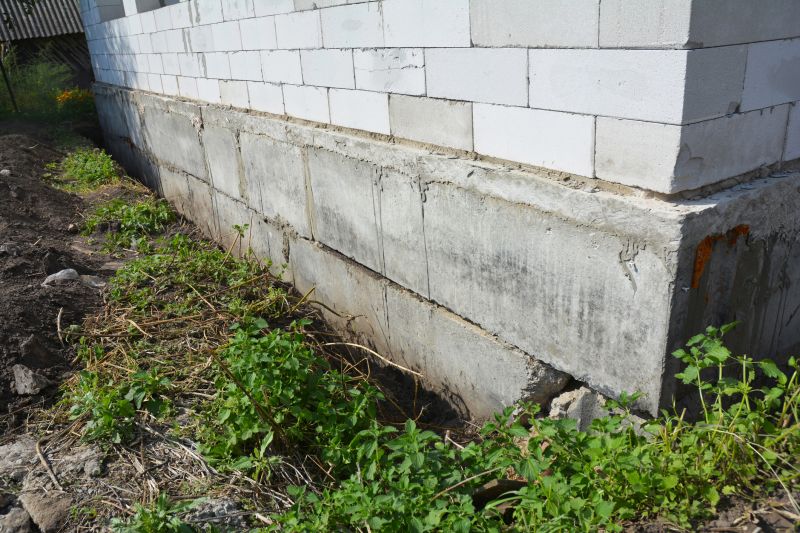Essential Foundation Repair Products For Long-Term Support
Choose from proven solutions that provide enduring support and stability to safeguard your home’s foundation over time.
 Foundation repairs are essential for maintaining the stability and safety of a structure, especially in areas prone to soil movement or moisture fluctuations. Selecting the right products for foundation repair can help address issues such as settling, cracking, or shifting of the foundation. These products are designed to reinforce, stabilize, and restore the integrity of the foundation, ensuring long-term durability. When considering foundation repair products, it is important to understand the specific needs of the property, including the type of foundation, the extent of damage, and the soil conditions.
Foundation repairs are essential for maintaining the stability and safety of a structure, especially in areas prone to soil movement or moisture fluctuations. Selecting the right products for foundation repair can help address issues such as settling, cracking, or shifting of the foundation. These products are designed to reinforce, stabilize, and restore the integrity of the foundation, ensuring long-term durability. When considering foundation repair products, it is important to understand the specific needs of the property, including the type of foundation, the extent of damage, and the soil conditions.
Top Overall Option
Hydraulic Pier Foundation Support System
A hydraulic pier foundation support system offers a versatile and adjustable solution for stabilizing and leveling foundations. It involves installing steel piers beneath the foundation and using hydraulic jacks to lift and support the structure. This method can accommodate various soil conditions and is suitable for addressing settling or uneven foundations. Properly installed hydraulic piers can provide a reliable means of restoring stability while allowing for future adjustments if necessary.
Types of Products For Foundation Repairs
Push Piers
Push piers are steel piers driven into the ground to stabilize and lift sinking foundations, often used in cases of settling.
Helical Piers
Helical piers are screw-like steel supports that are rotated into the soil, providing stability in various soil types.
Slab Jacking
A method that involves injecting a grout mixture beneath a concrete slab to lift and level it, often used for driveways and sidewalks.
Underpinning Systems
Underpinning involves strengthening and stabilizing existing foundations by extending them to more stable soil layers.
Mudjacking
Similar to slab jacking, mudjacking uses a slurry mixture to lift and stabilize sunken concrete surfaces.
Carbon Fiber Reinforcement
Carbon fiber strips are used to reinforce cracked concrete and prevent further movement or cracking.
Resin Injection
Resin injections are used to fill cracks and voids within the foundation or concrete slabs to restore integrity.
Soil Stabilization Products
These products improve soil strength and reduce shifting, often used before foundation repair work.
Lift and Level Equipment
Hydraulic jacks and lifting systems are employed to raise and level uneven foundations or slabs.
Crack Repair Sealants
Sealants and fillers are used to close cracks in foundations and walls, preventing water intrusion and further damage.
Drainage Solutions
Proper drainage products help manage water flow around the foundation, reducing soil erosion and moisture issues.
Vapor Barriers
Vapor barriers are installed to control moisture levels beneath slabs, protecting against expansion and contraction.
Popular Choices
Push piers are commonly used for stabilizing sinking foundations, offering adjustable support.
Helical piers are favored for their ease of installation and suitability for various soil conditions.
A minimally invasive method for lifting sunken concrete slabs, popular for driveways and patios.
Used to reinforce cracks and prevent further movement in concrete walls and slabs.
Resin injection products are widely used for crack sealing and structural repairs.
Hydraulic jacks and lifts are popular for their precision in leveling and raising foundations.
Underpinning piles provide additional support beneath existing foundations, often used in complex repairs.
Effective drainage solutions are in high demand to prevent water-related foundation issues.
Vapor barriers are commonly installed to control moisture and protect slabs from damage.
In Laguna Niguel, CA, where soil conditions and climate can influence foundation stability, choosing appropriate repair solutions is crucial. Professional assessment and consultation are often recommended to determine the most suitable products and methods. From hydraulic piers to underpinning systems, there are numerous options available to suit different scenarios. Proper installation and quality materials are vital to achieving effective and lasting results.
Investing in quality foundation repair products can help prevent more severe structural issues over time. It is advisable to work with experienced contractors who can recommend and properly install these products. Regular inspections and maintenance can also prolong the lifespan of the repairs and ensure ongoing stability. Whether dealing with minor cracks or significant shifts, understanding the available products and their applications can empower homeowners and property managers to make informed decisions.
Key Buying Considerations
- Assess the extent and type of foundation damage to determine suitable repair products.
- Understand soil conditions and how they influence the choice of foundation support systems.
- Choose products compatible with the foundation type, whether slab, crawl space, or basement.
- Consider the load-bearing capacity and adjustability of support systems for future modifications.
- Evaluate the ease of installation and whether professional assistance is recommended.
- Check material durability and resistance to environmental factors such as moisture and corrosion.
- Review manufacturer specifications and warranties to ensure product reliability.
- Determine the compatibility of repair products with existing foundation materials.
- Prioritize products that allow for future adjustments or repairs if necessary.
- Consider the overall cost, including installation and potential maintenance needs.
- Research local building codes and regulations to ensure compliance with repair methods.
- Look for products with proven performance in similar soil and climate conditions.
- Evaluate the availability of technical support and customer service from suppliers.
- Decide on the scope of repair—whether temporary stabilization or permanent solutions.
